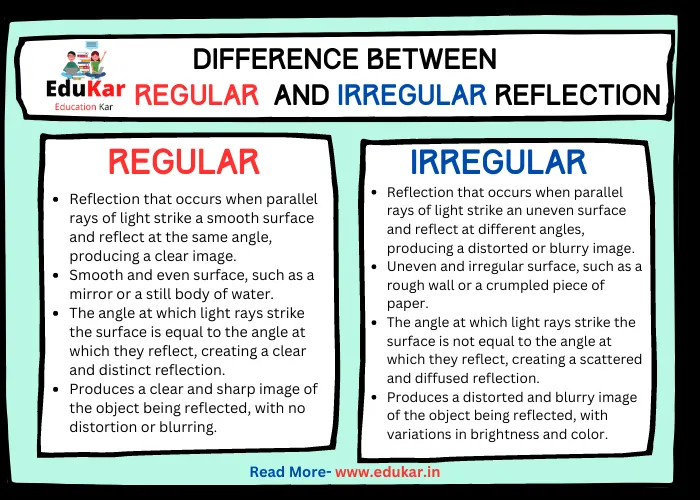Learn about the key differences between regular and irregular reflection in this comprehensive guide. Explore how light interacts with different surfaces, and discover the crucial role that reflection plays in our understanding of the world around us.

Introduction
Reflection is a common phenomenon that occurs when light bounces off an object and changes direction. This can happen in different ways, leading to two types of reflection: regular and irregular reflection. It is important to understand the differences between these two types of reflection, as they have different properties and applications.
Regular Reflection
Regular reflection, also known as specular reflection, occurs when light waves reflect off a smooth surface and bounce off at a single angle, known as the angle of incidence, in a predictable manner. This results in a clear and focused image of the reflected object. Regular reflection is responsible for the reflective properties of mirrors, glass, and other smooth surfaces.
In everyday life, regular reflection is often used in mirrors, which are designed to provide clear, undistorted images of objects. Regular reflection is also used in telescopes and other optical devices, where it is used to focus and magnify light.
Irregular Reflection
Irregular reflection, also known as diffuse reflection, occurs when light waves reflect off a rough or uneven surface and bounce off in different directions, scattering the light. This results in a scattered image that is not as clear or focused as that produced by regular reflection. Irregular reflection is responsible for the appearance of matte surfaces, such as paper, and the diffuse appearance of objects in natural light.
In everyday life, irregular reflection is often seen in matte surfaces, which are designed to reduce glare and provide a more diffuse reflection of light. Irregular reflection is also used in photography, where it is used to create softer, more natural-looking lighting.
Difference between Regular and Irregular Reflection
| Regular Reflection | Irregular Reflection | |
|---|---|---|
| Definition | Reflection that occurs when parallel rays of light strike a smooth surface and reflect at the same angle, producing a clear image. | Reflection that occurs when parallel rays of light strike an uneven surface and reflect at different angles, producing a distorted or blurry image. |
| Surface | Smooth and even surface, such as a mirror or a still body of water. | Uneven and irregular surface, such as a rough wall or a crumpled piece of paper. |
| Angle of Incidence | The angle at which light rays strike the surface is equal to the angle at which they reflect, creating a clear and distinct reflection. | The angle at which light rays strike the surface is not equal to the angle at which they reflect, creating a scattered and diffused reflection. |
| Image Formation | Produces a clear and sharp image of the object being reflected, with no distortion or blurring. | Produces a distorted and blurry image of the object being reflected, with variations in brightness and color. |
| Reflection Intensity | The intensity of the reflection is uniform across the entire reflected image, with no variations in brightness or color. | The intensity of the reflection varies across the reflected image, with variations in brightness and color due to the uneven surface. |
| Examples | Mirrors, still bodies of water, polished metal surfaces. | Rough walls, crumpled paper, frosted glass. |
| Law of Reflection | Follows the law of reflection, which states that the angle of incidence is equal to the angle of reflection. | Does not follow the law of reflection, as the angles of incidence and reflection are not equal. |
| Parallelism | Produces parallel rays of reflected light, with each ray maintaining its original direction. | Produces scattered and diverging rays of reflected light, with each ray changing direction based on the irregularities of the surface. |
| Distance Perception | Produces accurate distance perception, as the reflected image is clear and sharp. | Can produce inaccurate distance perception, as the reflected image is distorted and blurry. |
| Applicability | Used in mirrors, telescopes, and other optical instruments that require clear and sharp images. | Used in art and design to create abstract and distorted images, or in security applications to obscure sensitive information. |
Real-World Examples of Regular and Irregular Reflection
A common example of regular reflection is the reflection of light off a smooth pool of water. The light waves reflect off the surface at a single angle, resulting in a clear and focused image of the surroundings.
In contrast, a common example of irregular reflection is the reflection of light off a rough wall. The light waves reflect off the uneven surface at different angles, resulting in a scattered and diffuse reflection.
Conclusion
Understanding the difference between regular and irregular reflection is important for a variety of applications, including the design of mirrors, optical devices, and lighting systems. By understanding the properties of each type of reflection, scientists and engineers can design materials and devices that take advantage of these properties and provide the desired level of reflection. Whether you are designing a new mirror or simply looking at your reflection in a window, knowing the difference between regular and irregular reflection can help you understand the properties of the light that you are seeing.
FAQs
What is regular reflection?
Regular reflection is the reflection of light from a smooth and shiny surface, such as a mirror, where the incoming light rays are reflected in a single direction and produce a clear and sharp image.
What is irregular reflection?
Irregular reflection, also known as diffuse reflection, occurs when light is reflected from a rough surface in multiple directions, resulting in a scattered and blurry reflection.
What causes regular reflection?
Regular reflection is caused by the smooth surface of the object, which allows the incoming light rays to be reflected at the same angle as the incident angle.
What causes irregular reflection?
Irregular reflection is caused by the rough and uneven surface of the object, which causes the incoming light rays to be reflected in many different directions.
Can regular reflection produce an image?
Yes, regular reflection can produce a clear and sharp image of the object being reflected.
Can irregular reflection produce an image?
No, irregular reflection produces a scattered and blurry reflection that does not produce a clear image of the object being reflected.
Where can regular reflection be observed?
Regular reflection can be observed in mirrors, still bodies of water, and other smooth and reflective surfaces.
Where can irregular reflection be observed?
Irregular reflection can be observed in rough surfaces such as walls, paper, and other textured surfaces.




